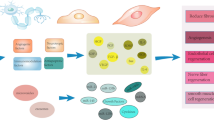Abstract
Bladder wall replacement is one of the most challenging problems of urologic surgery. Various materials have been tried in experimental models, but most were not free of complications, such as leakage, infection, and stone formation. In addition, much time was needed for tissue regeneration after grafting. Bladder replacement with tissue-engineered materials, which basically consist of autologous cells seeded on a supporting structure, represents an area of rapidly expanding interest. Recently, several investigators have reported important, successful results from in vitro systems and animal models. Here we review those experimental approaches to tissue-engineered artificial urothelium.
Similar content being viewed by others
Author information
Authors and Affiliations
Additional information
E-pub: 14 August 2000
Rights and permissions
About this article
Cite this article
Kawai, K., Hattori, K. & Akaza, H. Tissue-engineered Artificial Urothelium. World J. Surg. 24, 1160–1162 (2000). https://doi.org/10.1007/s002680010194
Published:
Issue Date:
DOI: https://doi.org/10.1007/s002680010194




